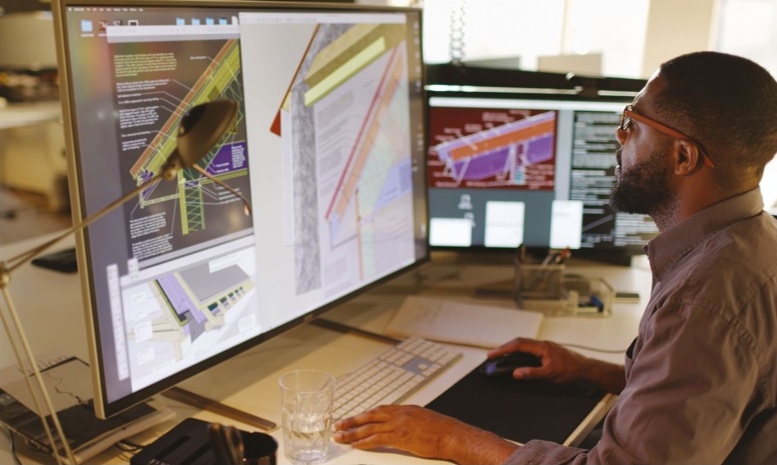
Workstations are the most powerful desktop PCs around, but budgetary constraints still apply. You need to choose your components wisely – and that means focusing your money on the workloads you generally perform. The good news: it’s no longer necessary to compromise too much between systems that are biased towards real-time graphics display and those aimed at final output. However, you should still spend the most on the components that will benefit your workload in order to get the best workstation for you.
1. Processor
Processors have moved on a generation since our last workstation Labs. The AMD Ryzen 9000 series arrived just in time for this test, when last year we had the previous 7000 series. Intel Core CPUs have moved from 13th (Raptor Lake-S) to 14th (Raptor Lake-S Refresh), and Threadripper Pro from 5000 to 7000 series. Most significantly for higher-end workstations, the non-Pro AMD Ryzen Threadripper is back, having skipped the 5000 series.
Intel hasn’t increased the number of cores with the 14th generation. The top Core i9-14900 processors still have eight P performance cores, which support Hyper-Threading, and 16 E efficiency cores, which don’t. This means they provide 32 threads, the same as a 16-core processor from AMD, but from 24 real cores, which makes for a good balance of capabilities between workloads that favor single and multithreaded environments.
The main difference between the 13th and 14th generations of Intel Core processors is a little more clock speed thanks to production optimization. They’re both manufactured using the 7nm-equivalent Intel 7 process. While 16 cores remain the pinnacle of the AMD 9000 series so far, the same as the 7000 series, this generation does come with “die shrink” from 5nm features to 4nm. With the AMD Ryzen 9000 series, therefore, the performance improvement is going to be more pronounced compared to the 7000 series (which our testing also implies), so make sure you get the latest CPU.
Both Intel and AMD mainstream processors are great for a range of activities, but if your workload is more optimized for multiple threads, the AMD Ryzen Threadripper is the primary choice. The Intel Xeon still hasn’t made a comeback (see “What has happened to Intel processors?”, p91). However, you can now choose between the Threadripper and its Pro variant. The latter has a wider range, going up to 96 cores and down to 12 cores, while the non-Pro is only available with 24, 32 and 64 cores. But for Pro and non-Pro CPUs with the same number of cores, the base and Boost frequencies are the same.
However, the Pro is significantly more expensive than an equivalent non-Pro, as are the motherboards supporting it, meaning you should only choose it if you need its additional features. The main ones here are support for eight-channel memory, where the non-Pro is only quad channel, so in theory the Pro can offer twice the RAM bandwidth. The Pro also has 128 PCI Express 5 lanes versus 48 for the non-Pro, which also has 24 PCI Express 4 lanes. This means the Pro can support more peripherals running at the full x16 mode, such as multiple powerful GPUs and high-speed networking adapters. If you don’t need these capabilities, the basic Threadripper is much more cost-effective, and we’re glad to see it back on the market.
2. Memory
Last year, we were still at the tail end of the transition from DDR4 to DDR5. But now all the latest CPUs support DDR5 memory, which theoretically provides at least twice the bandwidth. There is some variation in the DIMM speeds supported, but that has less impact than the generation, the amount installed and how many channels are operated in parallel.
While we would still say 32GB is an absolute bare minimum amount of RAM for content creation work, 64GB is fast becoming the baseline. This month, only two system came with just this amount, and the rest had more. The more memory the system has, the smoother your workflow will be with large 3D datasets or when working with huge images and 4K video. Now that processors have so many cores, more RAM helps these run multiple applications simultaneously; for example, when encoding a finished video edit in the background while working on the next one.
Both Intel Core and AMD Ryzen processors offer dual-channel memory, so DIMMs should be installed in matched pairs. Motherboards for these processors will usually have four DIMM slots, although some mini-ITX boards only have two. Ryzen Threadripper supports quad-channel memory, so should have four matching DIMMs to take advantage of the performance benefits of this capability. Similarly, with Threadripper Pro’s eight-channel support, eight matching DIMMs are required to enable the full bandwidth available. Buying a Threadripper Pro system and not using its eight-channel memory facility is missing out on one of the unique features you paid extra for.
3. Graphics acceleration
Most content creation will require live rendering of design work. If any of this involves 3D, such as film or TV animation, CAD, engineering or product design, you’re going to need a fast graphics accelerator. Professional GPUs are more expensive than consumer-grade ones, and for some types of activity the latter might be a valid choice. For example, game developers may want to test their designs on the same PC they use for creation, so having a gaming card makes sense.
However, professional graphics card ranges generally have longer warranties and come with specific support for professional software. They will also be optimized for this software. A particularly telling example is Siemens NX, which runs very slowly on consumer-grade GPUs with gaming drivers. Surprisingly, although all the systems on test this month support PCI-E 5 peripherals, none of the current generation of graphics cards requires this.
Although the performance competition between AMD and Nvidia continues, only three of the systems this month came with Radeon Pro accelerators, while the rest had Nvidia RTX and GeForce cards. This shows that AMD is continually facing difficulties gaining share in the professional workstation space, although its Instinct accelerators are finding favour further up the market.
The Nvidia RTX 4000 Ada Generation is a solid baseline for high-end professional acceleration for content creation, costing around £1,300. The 4500 Ada Generation is around £2,500, so you pay a lot more for this increment in performance, while the 5000 Ada Generation is around £4,200. The AMD Radeon Pro W7800 also costs £2,500, and offers similar performance to the 4500, while the W7900 is over £3,800. It can beat the Nvidia RTX 5000 Ada Generation in some tests.
There’s no definitive overall answer to the question whether AMD or Nvidia are better choices for professional graphics. It’s best to pinpoint what your main visualization workloads will be, look at the benchmarks, and choose which is generally best for those activities within the price range you can afford.
However, the incredible power of GPUs is increasingly being harnessed for other activities. They’re so good at rendering 3D in real-time that it’s no surprise that they can be very quick at outputting 3D animation frames, too. But they also have a part to play in the current AI revolution. We’ve dipped our toes in this water with one test of this capability, but expect it to grow in value soon. Watch this space.
4. Storage
Most workstations in the past used to combine a fast boot-up and application drive with cheaper secondary storage for data. However, as the capacity of super-fast SSDs has increased and their cost gone down, this is less of a necessity, and not all systems this month provide more than one storage device. If you work with massive video files, you will still want a lot of capacity. But otherwise, a 2TB drive will keep things going and a 4TB one will be adequate for a long time.
The latest PCI-E 5 NVMe M.2 SSDs can deliver well over 10,000MB/sec reading speeds, and often surpass this for writing. Even the quickest SATA conventional hard disks will provide around 40 times lower throughput. They still offer the most capacity for the money, and if you need more than 4TB then flash storage is going to be extremely expensive. A sensible way of working these days is having enough flash storage in your system for a few projects, and then use a large USB-C-attached external device as backup. Archiving and retrieval may take a little time, but your workflow will be rapid on the system itself.
5. Chassis
There isn’t a bad chassis in evidence this month. The Fractal Design Meshify that was popular last year has surprisingly disappeared, but we still have a couple of Fractal Define 7 cases. These have an unassuming appearance but are well made. The Fractal North variants used by Scan look fantastic, as does the tiny Phanteks Evolv Shift XT supplied by Armari. The latter has also delivered one of its own-brand chassis, which is purpose-built for workstation applications. Lenovo’s chassis is also well made for easy maintenance. However, the main thing to look for is whether there are enough drive mounts should you need to add more storage. Armari’s case provides easy-fit caddies for this, making it particularly well endowed in this area.
6. Power supply
The final component to consider for a workstation is the power supply. These are performance-oriented systems, and they eat watts for breakfast, so you need to be sure that your PSU can cope. A 750W supply is a bare minimum in these days of power-hungry CPUs and GPUs. For a Threadripper system, we recommend over 1,000W. Also take note of efficiency. At least Gold is essential, and Platinum even better. This indicates that very little power will be lost converting from 240V AC to the various DC feeds within the computer.







